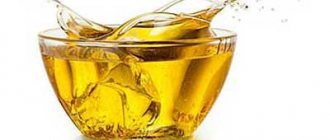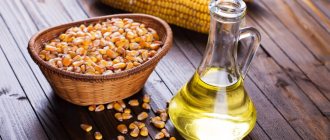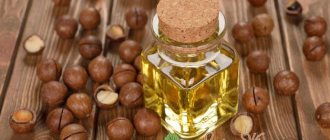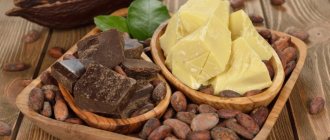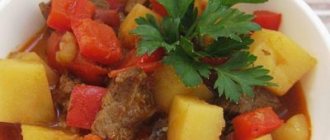Olive oil in cooking is called Provençal or wood. Refers to . The fleshy parts and kernels of olive seeds are used to make it. The highest quality varieties with a delicate soft taste and pleasant aroma of olives are obtained by cold pressing.
Olives are grown in Mediterranean countries, and the finished product is supplied to us from Greece, Cyprus, Turkey, and Spain.
Since ancient times, an olive branch covered with leaves has served as a symbol of abundance and peace, purification and blessing. It was awarded to the winners of sports competitions and bloody wars.
Olive oil is composed of various triglycerides, which contain oleic acid in large quantities. Olive contains three very valuable substances for cosmetology - squalane, squalene and phenol.
. Each of these substances has healing properties. For example, squalane and squalene have a beneficial effect on the appearance of the skin. Therefore, these substances are readily used in the production of cosmetics for face and body skin care. And phenol protects against aging; it is added to anti-aging creams.
It can be used to treat brittle split ends. It is enough to pamper your hair twice a week with a nourishing mask with olive extract.
The mask can be prepared at home; for this you will need 1 spoon of high-quality vegetable and olive oil and 1 tsp. yolk and honey. The mask softens and nourishes the hair; as a result, luxurious hair does not suffer from problems such as hair loss or fragility.
Now you don't have to buy store-bought massage oils. Simply warm up to body temperature and use as directed. An olive massage will nourish the skin with moisture, remove toxins, increase blood circulation and generally be beneficial.
The value of oil in the diet is due to its ability to simultaneously maintain the level of its beneficial counterpart.
Olive oil is a wonderful dietary component necessary for human health - it is one of the healthiest oils.
Benefit
Frying, dressing salads and generally cooking with this oil is much tastier and healthier than with sunflower oil. It is used in cooking to prepare a wide variety of dishes: frying fish, meat, and vegetables cannot be done without this miracle product. It is added to first, second courses and side dishes. The oil is known not only for its taste, but also for its benefits to the digestive tract.
A large amount of oleic acid helps the body absorb useful elements, improves appetite, and promotes good metabolism.
Constant but moderate consumption of this product will prevent many diseases. Olive leaves are a component of many medications that lower blood pressure.
It is useful to use for the prevention of cardiovascular diseases.
The oil reduces the decrease in calcium in bone tissue, which is why it is so useful for children. Linoleic acids help heal burns, increase muscle tone, restore the nervous system and even improve coordination of movements. It also reduces the risk of tumors.
Fatty acids, antioxidants and vitamins prevent the development of cancer cells and help reduce harmful substances and toxins in the human body.
Harm
The benefits of olive oil for the body are very great, but it should be added to the diet in small quantities. Otherwise, it may have a bad effect on your stomach. Has a choleretic effect. For example, with cholecystitis, the disease may worsen. An adult, without harm to health, can consume about 3 tablespoons per day.
It is better to choose and buy unrefined, which has been subjected to less heat treatment and retains many more useful elements in its composition than refined. But such oil is also much more expensive. It is better to give preference to natural olive oil, always in glass containers.
Some manufacturers cheat and mix different varieties, which greatly reduces the beneficial composition and properties of the oil. If the product label says mix, then it is better not to buy it. It is important to remember that the shelf life of high-quality unrefined oil is no more than five to six months.
Calorie content and composition
FAQ:
- Calories and volume of a teaspoon of olive oil?
- How many calories are in 100 grams and a tablespoon?
- What is the volume of a tablespoon?
- How many proteins, fats and carbohydrates per 100 grams of product?
- What is the content of vitamins and minerals in 100 grams of oil?
100 grams contain:
- Protein – 0.0 g;
- Fat – 99.9 g;
- Carbohydrates – 0.0 g;
- Vitamins (tocopherol) – 15.0 mg.
In 1 teaspoon
Net weight of one liter is 908 grams. This means that there are 0.9 grams in one ml. One teaspoon contains 5 ml of oil, which is 4.5 grams. If we take into account that – 898 kcal, and in 1 g – 8.98 calories, it means:
4.5*8.98 = 40.41 kcal.
In 100 grams
One hundred grams of oil contains 898 kcal – this is a lot. Nothing bad will happen if you eat a salad seasoned with oil once a day.
But abuse of the product, especially if you are overweight, can result in a deterioration in your health.
In a tablespoon
There are 17 grams of product in a tablespoon, that is, approximately 15.3 ml and 152.6 kcal.
It won’t hurt, but may even be beneficial for an adult to include 1.5–3 tablespoons of oil in their daily diet.
Your feedback on the article:
- It is believed that olive oil is healthier than sunflower oil, but this is not so - scientists have proven that sunflower oil is no less healthy than olive oil, but in terms of calorie content, both sunflower and olive oil are almost the same and 1 teaspoon contains 47-50 kilocalories. Moreover, if you consume olive oil with vegetables, then you should not be afraid of gaining weight, since together with vegetables, olive and sunflower oils are not stored as fat, but are completely processed by the body.
One liter of refined olive oil weighs 908 g. One milliliter weighs 0.9 g.
One teaspoon contains 5 ml. Accordingly, the weight of a teaspoon of olive oil is 4.5g.
Calorie content of 100 grams of butter = 898 Kcal. One gram - 8.98 Kcal.
4.5*8.98 = 40.41 kcal.
It is believed that you can take no more than 2 tablespoons of olive oil per day.
Teaspoons are now different, there are a little more, and there are a little less, but on average, a teaspoon of olive oil contains about 46 kcal. But don’t be afraid to eat this oil; on the contrary, if you eat salads seasoned with olive oil every day, your weight may gradually decrease rather than gain. Olive oil improves metabolism in the body, but only extra virgin oil.
It is impossible to put all olive oil under one comb and derive the number of calories, since the oil is pressed from different varieties and quality of olives, and also the pressing mechanism is different for all manufacturers, so the data can only be given approximate, based on any one variety and oil manufacturer.
Many sites provide information like this:
per 100 g (attention!) edible part in olive oil contains 898 kcal
But nowhere is the type of oil described, on the basis of which these data were taken, so I personally question this figure, but since there are no others, I will build on the figures that exist.
So in 100 grams there are 898 kcal, and in a teaspoon there are approximately (since everyone is different) 5 grams of olive oil, based on this we find that one teaspoon contains approximately up to:
Why is it better to lose weight with olive oil than with sunflower oil?
Olive oil has become a serious competitor to sunflower oil. Although their energy value is almost the same, nutritionists strongly recommend losing weight with the Provençal product. It, as already indicated, contains 898 kcal per 100 g, and 899 kcal in oil obtained from sunflower seeds.
And olive oil is not much behind other vegetable fats in terms of calorie content: one tablespoon of various oils has the following energy value:
- sunflower - 120 kcal;
- peanut and corn - 152.8 kcal each;
- mustard - 152.7 kcal;
- sesame and flaxseed – 120 kcal each;
- almond – 182.7 kcal;
- soybean – 152.8 kcal.
Thus, if we evaluate olive oil from the standpoint of calorie content, then it has no advantages over other similar products. Its advantage is that it is a low-cholesterol product and also contains many vitamins.
Olive oil for weight loss
Despite the relatively high calorie content of olive oil, it can be used for weight loss
(within reasonable limits, of course). If you do not exceed a reasonable amount of 2 tablespoons per day, this oil will help you lose weight. But you need to take it correctly.
Olive oil for weight loss is recommended to take 1 tablespoon on an empty stomach 1 hour before breakfast. To prevent gastritis, you can drink it with a glass of water. To cleanse the liver and stimulate weight loss, you can mix olive oil for weight loss with lemon juice (for 1 lemon - ¼ cup of oil).
The oil acts in several directions at once. Firstly, it reduces appetite. Secondly, it regulates the functioning of insulin, preventing it from converting carbohydrates into fat. Thirdly, it stimulates metabolic processes in the body, promoting the breakdown of fats. Fourthly, it cleanses the body of toxins, waste and other harmful substances. Fifthly, it has a general healing effect on the body. In addition to being effective for weight loss, olive oil has a very good effect on the condition of the skin, hair and nails thanks to beneficial fatty acids and vitamin E, which it contains in large quantities.
In addition to consuming the oil in its pure form, you can use it as regular vegetable oil. Replace animal fats, margarine and sunflower oil with olive oil and use it for salad dressing (unrefined) or for frying and adding to baked goods (refined). Remember that unrefined oil cannot be used for frying, as when heated, carcinogenic substances begin to form in it and it becomes harmful.
You should know that if you have cholecystitis or cholelithiasis, you should not use olive oil for weight loss.
, as it may cause the stones to move.
Everything for health: how can you use olive oil?
The scope of use of olive oil is not limited to cooking. It is useful for ulcer sufferers as it promotes ulcer healing. It will also help those who suffer from constipation, because it activates intestinal motility. The oil will improve the functioning of the heart.
If you constantly include vegetable salads flavored with olive oil in your menu, you can get rid of fat deposits and lose weight.
“Wood oil” nourishes and strengthens hair well. For this purpose it is used in the form of masks. Face masks also provide an equally impressive positive effect. They restore water balance and elasticity of the skin.
Calorie content of olives and olives
Olives and black olives are the fruits of the olive tree. It must be said that the division into “olives” and “olives” exists only in Russia. In fact, these fruits are no different - neither in the degree of ripeness, nor in the variety, these are the fruits of the same tree, the only difference is in the processing technologies. Olives (black fruits) contain more chemicals, which means they are less healthy than green fruits. The calorie content of black olives and black olives is approximately the same.
. The technology of preserving “olives” changes the taste of these fruits in such a way that they are then used only in their pure form, not stuffed with anything, since their taste does not combine with other products that are used to stuff olives. Due to this, the calorie content of canned olives may differ from the calorie content of olives stuffed with any foods. The healthiest canned olives are those that have been salted in sea water without adding preservatives or stabilizers - they are harder to find and they are more expensive, but the benefits of such olives are many times greater than those of ordinary canned olives.
The calorie content of fresh olives is 115 kcal per 100 g. Olives contain about 7% olive oil, as well as proteins and carbohydrates. The calorie content of canned olives is about 170-180 kcal per 100 g.
Precautionary measures
Excessive consumption of this healthy product can harm the body, and it’s not just about calories - the danger is the choleretic effect of this product.
It is also harmful to consume stale oil (one that has not been stored in the refrigerator or hidden from sunlight; an indicator that the oil has spoiled is that it begins to smoke when heated). Olive oil has a fairly short shelf life, so be careful not to use expired oil.
Sometimes individual intolerance to this product occurs, so if, after starting to take olive oil, any unpleasant symptoms appear in the gastrointestinal tract, liver, excretory system or other internal organs, stop taking the oil and consult a doctor - perhaps your body is letting you know that it is your health is not all right.
If you liked this article, please vote for it:
(25 Votes)
Calories, kcal:
Proteins, g:
Carbohydrates, g:
Olive oil is the name given to vegetable oil, the raw materials for which are the fruits of the olive tree, and. The exact date of the first use of olive oil has not been officially established, but already in Ancient Greece olive oil was called “liquid gold” and was used to pay for services. Olive oil is a thick transparent liquid from light yellow to yellow-green color, with a strong odor and bright taste.
Olives are traditionally harvested by hand, then the berries are crushed and gently mixed, repeating the pressure several times using manual or mechanical presses. The highest quality oil - extra virgin olive oil
- the so-called first cold press, without additional heating, has a bitter taste with a slight burning sensation. The main suppliers of olive oil are Spain, Greece, Italy, and Türkiye.
Calorie content of olive oil
The calorie content of olive oil is 898 kcal per 100 grams of product.
Composition and beneficial properties of olive oil
Olive oil contains Omega-3 unsaturated fatty acids, which reduce the risk of developing cardiovascular diseases. Consumption of olive oil helps to effectively reduce the level of “bad” cholesterol in the blood and reduces the risk of malignant neoplasms, especially breast cancer. The product is rich in vitamins, and, which have a beneficial effect on the functioning of the digestive tract, nervous system, and improve the condition of the skin, nails and hair (calorizator). The beneficial properties of olive oil also include improving memory and stimulating brain activity, improving coordination of movements and visual acuity, and protecting the walls of the stomach from the formation of ulcers.
Olive oil for weight loss
Olive oil has the unique property of reducing appetite, therefore, by taking a teaspoon of oil before meals, you can reduce the portion of what you eat, since olive oil also promotes rapid satiety. Many diets and nutritional methods include olive oil in their diet, the most famous diet is.
Harmful olive oil
Despite the obvious benefits for health and beauty, it should be remembered that olive oil is a high-calorie fatty product, so it should be consumed in moderation. People with a history of cholecystitis should use olive oil as food with extreme caution.
Olive oil in cosmetology
Olive oil has long been used to moisturize skin, especially dry and sensitive skin. Olive oil fights peeling and irritation on the face and hands, restores lipid balance and promotes rapid healing of wounds. The product includes masks for skin and hair, nourishing shampoos and restorative balms, and massage products.
Olive oil is divided into:
- Natural ( Virgin olive oils
) - oil produced without chemical purification, suitable for cold use (salad dressings, sauces); - Refined ( Olive oil
) - physical and chemical processes are used in production, ideal for frying and baking foods; - Oil cake ( Olive-pomace oil
) - oil produced from the cake and pressings remaining after the first cold pressing, is rarely added to food.
There is olive oil that is not consumed as food - lamp oil, used as fuel for ritual lamps.
Selection and storage of olive oil
When purchasing oil, you need to choose a product in a dark glass bottle with a tight lid, produced in February, then the oil is made from ripe olives and has the best taste and aroma. You should pay attention to the acidity reading indicated on the label. Optimal acidity should not exceed 0.8 g per 100 g in terms of oleic acid.
Store olive oil in a cool, dark place, away from strong-smelling foods. If the oil is stored in the refrigerator, a sediment may form, which disappears when heated.
Olive oil in cooking
Extra virgin olive oil
) is suitable for preparing salad dressings and cold sauces, such as homemade mayonnaise. The main companions of the oil are and. Fish, meat, poultry, vegetables and cheese are fried and baked in purified, refined olive oil; it is added to dough for baking bread and muffins.
For more information about olive oil, watch the video “Olive Oil. Treasure of the Pyrenees" TV show "Live Healthy".
Especially for Copying this article in whole or in part is prohibited.
Olive vegetable oil, rich in vitamins and microelements, is used not only in cooking, but also for a healthy and proper diet. Despite its high calorie content, olive oil is a dietary product and is often used by those who are watching their figure.
Why is olive oil back in fashion?

Provençal, wood or olive oil was extremely popular back in Ancient Egypt, ancient Greece and Rome. Today it is on everyone's lips again. They talk about it on culinary talk shows, it is recommended by nutritionists, and cosmetologists talk about the wonderful properties of this product. Why exactly has it become the focus of attention of those who watch their figure and try to adhere to a healthy diet?
The point is both in the large set of useful properties and in the peculiarities of the technology for its production. Unlike other vegetable oils, it is extracted from seeds without the use of solvents or heat treatment. This allows you to preserve the entire set of nutrients and the unique aroma of olives. Unlike mayonnaise, it does not contain “chemicals”.
Olive oil, whose caloric content per 100 grams is 898 kcal, can hardly be called dietary. But such a high calorie count shouldn't scare anyone trying to lose weight. Unlike animal fats, it not only does not add weight, but even helps to reduce it, as it reduces the number of fat cells.
Now many are concerned about how to get rid of “bad” cholesterol. Since olive oil contains unsaturated fats, it reduces its amount, but does not reduce the concentration of beneficial ones. This way, the optimal balance of these important elements in the body is maintained. In addition, the oil was found to have anti-cancer properties and prolong life.
Composition, benefits
Olive oil consists exclusively of fats (BJU per 100 grams - 0.0 g/99.9 g/0.0 g). It is very useful due to easily digestible monounsaturated fatty acids (in particular, oleic acid), which directly affect the reduction of cholesterol levels in the body, strengthen and make the walls of blood vessels elastic.
Olive oil contains vitamins K, D, E, A, B3, and is also rich in calcium, sodium, magnesium, phosphorus and other trace elements.
This composition has a beneficial effect on the body:
- strengthens bone tissue;
- restores the walls of the intestinal tract;
- increases resistance to infections;
- slows down the aging process;
- improves muscle tone.
Linoleic acid present in the oil has a positive effect on vision, improves coordination of movements, and helps in wound healing.
Olive oil is especially popular among women. It is believed that its use prevents some forms of cancer: 100 grams per week reduces the risk of developing a malignant breast tumor by 4 times.
The oil is also widely used in cosmetology due to the valuable substances included in its composition: squalane, squalene and phenol. Used in the production of products for moisturizing, nourishing and firming the skin. Also good for hair.
Application
Olive oil is traditionally used as food and used for preparing various products. It can be used both raw and used for frying. Cuisines of many countries around the world include this oil in the most delicious recipes. Particular attention to this oil should be given to those who suffer from vascular diseases, as it helps remove cholesterol from the body. In addition, olive oil is widely used in the food industry as an important component of complex formulations.
In addition to using the oil as food, it is often included in various skin care cosmetics, as well as in some medicines.
In folk medicine, there are a number of recipes for various diseases that are treated with olive oil. These include problems with digestion, skin, hair, colds, and weak immunity.
Market Analytics
- COVID-19 is changing the rules of the game in the cosmetics market
- Beauty of the future: cosmetic innovations 2020
- New ingredients are the driving force of the cosmetics industry
Convenient search for beauty salons on our website
Beauty salons in Moscow Beauty salons in St. Petersburg Beauty salons in Ekaterinburg Beauty salons in Novosibirsk
Latest blog posts on our website
- Naturecream / Geranium (Pelargonium) oil for skin health and beauty
- Prostye-sovety / Save on a beauty salon: procedures that can be done at home
- Naturecream / Growth Factor - brings back youth?
- Oksana-Lezina / 3 effective abdominal exercises from a fitness instructor for beginners
- Prostye-sovety / Making perfect curls at home
- Prostye-sovety / Which hair removal method to choose
- Naturecream / Wrinkles Puppets
- Naturecream / PEPHA-TIGHT - instant skin lifting
- Naturecream / Blue light - a danger to the skin
- Naturecream / Cocoa Butter – A treat for the skin
Latest forum topics on our website
- Mrs._Smith / Badly sunburned! What to do?((
- Ice / Is it necessary to combine fitness classes with a diet?
- Antonova / What can be used for hair loss?
- Radio operatorKat / Who was on a protein diet?
- Suzanna / Mesotherapy on the face
Other articles in this section
| Unsalted peasant butter Peasant butter is made from high-fat cream. After a thorough churning process, milk fat is obtained - butter. Unsalted butter is made in the same way as regular butter, only it does not contain salt. Peasant unsalted butter can be found on store shelves in the form of packages weighing from 180-190 grams. |
| Peanut oil Peanut oil can be obtained by cold pressing or by exposing the nut pulp to organic matter. The cooking method you choose affects the color of the finished product. For example, in Asia, unrefined nut oil is widely used, which has a distinct nutty aroma and flavor. In Europe and America, the production of refined peanut oil is popular. |
| Almond oil Almonds are a short tree belonging to the plum genus. The plant has an unusual feature: its flowers bloom first, and then leaves appear. It is considered a plant of the subtropical and tropical zones. It grows in such countries of the Mediterranean region as Tunisia, Greece, Italy, Spain. It is also found in the USA and China. |
| Table milk margarine If you take butter and table milk margarine in your hands, you will notice that they are like twins in appearance. They are similar not only in appearance. The body's digestibility, composition, and nutritional value of these products are also very similar. You can also note a similar taste and aroma. This happens because fermented milk is added to table milk margarine during the manufacturing process. That is, emulsification of milk and fat occurs. Pasteurized milk is fermented with bacteria, so it takes on the aroma and taste of milk. And it is worth noting that only milk margarine contains the addition of whale oil in the amount of 25%. |
| Cocoa butter Cocoa butter is a fat obtained from the ground beans of the chocolate tree by pressing crushed and roasted cocoa beans. This oil serves as the basis for our most favorite dessert - chocolate. Cocoa butter has a yellowish or white color, a dense consistency and has a pleasant smell and taste. |
| Cottonseed oil Cottonseed oil is produced by cold pressing of cotton seeds. Unrefined oil has a dark red color and a rather pungent odor. After processing, the already refined oil has a light yellow color, is practically odorless, and is characterized by a slight nutty flavor. Cottonseed oil is very popular in Central Asia - there it is used everywhere in its homeland, like sunflower oil in Russia. It is also popular among residents of America, where cotton is considered a national treasure. |
| Corn oil Corn oil is one of the best vegetable oils. It is produced from the seeds and germs of corn, which is rightfully considered a valuable agricultural crop. |
| Shea butter (karite) Shea butter has been known to mankind for centuries. Its country of origin is Africa. It is on the African continent that the shea tree (also called karite) grows, whose lifespan is about 300 years. The fruits of the tree resemble an avocado in shape and have aromatic pulp. |
| Sea buckthorn oil The oil from this plant has been widely known for centuries. This product is prepared from well-ripened sea buckthorn berries. |
| Wheat germ oil Wheat is very popular among other grains because it provides the consumer with a wide variety of products with unique nutritional value. One of them is oil extracted from fresh wheat germ using cold pressing. |
Recipes for popular dietary dishes with olive oil
Avocado salad
Ingredients :
- 140 g bell pepper;
- 100 g avocado;
- 160 g tomatoes;
- 100 g cucumbers;
- 100 g of Chinese cabbage;
- 50 g green onions;
- 1 tbsp. l. wine vinegar;
- 1 tbsp. l. olive oil;
- salt to taste.
Wash the pepper, remove the stem, remove seeds, and chop. Chop the cabbage, finely chop the remaining products. Place everything in a salad bowl. Salt and season.
The calorie content of the salad is 60 kcal per 100 grams.
Greek salad
- 140 g bell pepper;
- 100 g tomatoes;
- 100 g cucumbers;
- lettuce and basil leaves;
- 100 g olives;
- 70 g feta cheese.
Finely chop everything and season.
Calorie content - 130 kcal per 100 grams of salad.
Salad composition in Spanish
- 100 g olives;
- 4 onions;
- half a bunch of parsley;
- 3 tbsp. l. vinegar (wine);
- 3 tbsp. l. oils; ground black pepper, salt.
Peel the onion and boil in salted water until soft, drain in a colander and dry. Slice and place on a plate. Chop the greens and sprinkle on top of the onion. Place olives, cut into rings, on top of the greens. Mix wine vinegar with oil and season the dish.
Calorie content - 130 kcal per 100 grams.
How many calories are in 100 grams of butter?
Butter is a concentration of milk fat, and naturally, it cannot be low-calorie and dietary. How many calories are in one hundred grams of butter depends on several factors, in particular:
- what cream was used during separation;
- whether salt was added;
- what is the fat content of the finished product?
Most often, sweet-creamy unsalted butter is sold in our stores. It is prepared from cream with a fat content of 61 percent. About 565 kcal - this is how many calories are in 100 g of butter
of this type. If you like to eat bread with sweet-creamy unsalted butter, then do not overindulge in it - one such sandwich with butter contains 97-97 kcal.
Extra-virgin palm oil, obtained from the fruits of the oil palm - unrefined, with a very specific aroma and color. Most people in our latitudes find their smell peculiar, some even define it as repulsive. It is widely used in the food industry as a substitute for trans fats in recipes. Hydrogenated and partially hydrogenated palm oil - the situation here is the same as for coconut oil.
- But it is the healthiest version of palm oil.
- Refined - colorless and deodorized palm oil.
Scientific evidence on the health benefits of saturated vegetable fats is quite controversial.
If 67 percent cream was used, this butter is even more dangerous for the figure. 613 kcal - this is how many calories are in one hundred grams of butter
of this type. And even more so if the fat content is 72.5 percent. This oil is used in the preparation of puff pastry and shortcrust pastry, in biscuits and muffins. In principle, even with diets, these dishes are not categorically excluded from the menu, but you should not eat them too often.
Most support the idea that they increase levels of good cholesterol and bad cholesterol in the blood. However, they cannot be compared to saturated fat animals because their fatty acid content is not as high. The most commonly used are ground nuts, dates and other dry fruits, coconut chips.
Olive oil is the healthiest and contains no calories
They are suitable not only for Easter, but for every holiday. Since ancient times, the olive tree has been a source of fascination, admiration and magical charm. Its fruit-olive oil juice is a renowned symbol of health, longevity and beauty. It is no coincidence that Homer calls it “liquid gold.”
The most high-calorie butter
– with a fat content of 80 percent. Here we are talking about calorie content of 748 kcal per 100 grams. If you want to lose weight, it is better to avoid using this product.


